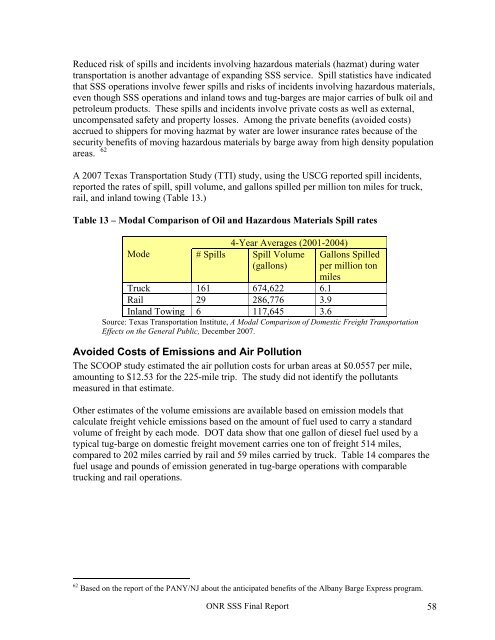Office of Naval Research - National Transportation Library
Office of Naval Research - National Transportation Library
Office of Naval Research - National Transportation Library
You also want an ePaper? Increase the reach of your titles
YUMPU automatically turns print PDFs into web optimized ePapers that Google loves.
Reduced risk <strong>of</strong> spills and incidents involving hazardous materials (hazmat) during watertransportation is another advantage <strong>of</strong> expanding SSS service. Spill statistics have indicatedthat SSS operations involve fewer spills and risks <strong>of</strong> incidents involving hazardous materials,even though SSS operations and inland tows and tug-barges are major carries <strong>of</strong> bulk oil andpetroleum products. These spills and incidents involve private costs as well as external,uncompensated safety and property losses. Among the private benefits (avoided costs)accrued to shippers for moving hazmat by water are lower insurance rates because <strong>of</strong> thesecurity benefits <strong>of</strong> moving hazardous materials by barge away from high density populationareas. 62A 2007 Texas <strong>Transportation</strong> Study (TTI) study, using the USCG reported spill incidents,reported the rates <strong>of</strong> spill, spill volume, and gallons spilled per million ton miles for truck,rail, and inland towing (Table 13.)Table 13 – Modal Comparison <strong>of</strong> Oil and Hazardous Materials Spill rates4-Year Averages (2001-2004)Mode # Spills Spill Volume(gallons)Gallons Spilledper million tonmilesTruck 161 674,622 6.1Rail 29 286,776 3.9Inland Towing 6 117,645 3.6Source: Texas <strong>Transportation</strong> Institute, A Modal Comparison <strong>of</strong> Domestic Freight <strong>Transportation</strong>Effects on the General Public, December 2007.Avoided Costs <strong>of</strong> Emissions and Air PollutionThe SCOOP study estimated the air pollution costs for urban areas at $0.0557 per mile,amounting to $12.53 for the 225-mile trip. The study did not identify the pollutantsmeasured in that estimate.Other estimates <strong>of</strong> the volume emissions are available based on emission models thatcalculate freight vehicle emissions based on the amount <strong>of</strong> fuel used to carry a standardvolume <strong>of</strong> freight by each mode. DOT data show that one gallon <strong>of</strong> diesel fuel used by atypical tug-barge on domestic freight movement carries one ton <strong>of</strong> freight 514 miles,compared to 202 miles carried by rail and 59 miles carried by truck. Table 14 compares thefuel usage and pounds <strong>of</strong> emission generated in tug-barge operations with comparabletrucking and rail operations.62 Based on the report <strong>of</strong> the PANY/NJ about the anticipated benefits <strong>of</strong> the Albany Barge Express program.ONR SSS Final Report 58
















